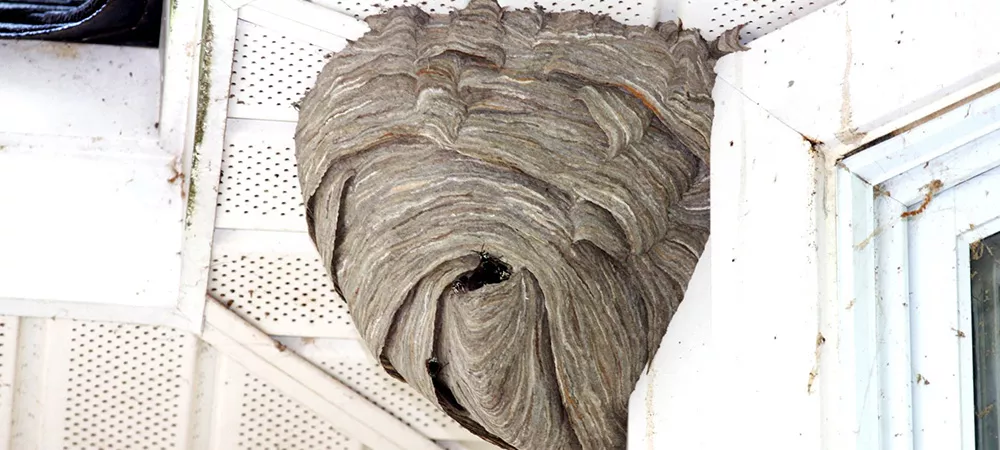How to Get Rid of a Hornets Nest in North Carolina

Hornets nests can be a nuisance and pose a danger to you and your family, particularly if someone in your household is allergic to insect stings. Identifying a hornet's nest is the first step in safely removing it from your property. There are a few key characteristics to look out for when identifying a hornet's nest. Hornets, such as the bald-faced hornet and European hornets, build large papery nests that typically hang from trees or other structures. These nests are often gray or brown in color and can range in size from a basketball to a beach ball. The nest entrance is usually located at the bottom and may have a tube-like opening.
Safety Precautions
When it comes to dealing with hornets nests, it is essential to prioritize safety measures to protect yourself and others from potential stings. Hornets can be aggressive when their nest is disturbed, and their stings can cause severe allergic reactions. Therefore, it is crucial to wear appropriate protective gear, including long-sleeved clothing, pants, closed-toe shoes, gloves, and a beekeeping veil or hat with a face shield. It is also advisable to perform the nest removal activities during the late evening or early morning, as the hornets are less active during these times. Additionally, inform others in the vicinity about the nest removal process and ensure they stay away from the area until it is safe.
Essential Protective Equipment for Removing a Hornets' Nest
When it comes to getting rid of a hornets nest, it is crucial to prioritize your safety. Protect yourself from stings by wearing the appropriate safety gear and clothing. This will ensure that you can deal with the nest effectively without putting yourself at risk.
- Thick Gloves: The first item you'll need is a pair of sturdy gloves, providing ample protection for your hands. Hornets possess potent stingers that can cause intense pain, making gloves indispensable in shielding your hands from their attacks.
- Goggles or Protective Eyewear: Additionally, it is crucial to wear goggles or protective eyewear to safeguard your eyes from potential hornet stings. These insects have the ability to cause painful reactions, so it is vital to shield your eyes from any harm.
- Long-Sleeved Shirt: To minimize exposed skin, it is highly recommended to wear a long-sleeved shirt, preferably made of thick fabric. This additional layer acts as a barrier against the hornets' stingers, reducing the risk of getting stung.
- Pants: It is essential to cover your legs with pants to protect them from potential hornet stings. By wearing pants, you create a physical barrier that reduces the likelihood of getting stung and minimizes the exposed skin area.
- Socks: Donning socks is crucial to protect your feet from hornet stings. Hornets are capable of inflicting painful reactions, so it is important to ensure your feet are adequately covered to prevent any potential stings.
- Closed-Toe Shoes: Closed-toe shoes are a necessary part of your protective gear when dealing with hornets. By wearing closed-toe shoes, you provide a sturdy barrier that shields your feet from any potential stings.
By equipping yourself with these essential protective items, you significantly reduce the risk of getting stung while removing a hornets nest. It is crucial to prioritize your safety and take the necessary precautions to minimize any potential harm.
Locating the Nest
To find a hornets nest, observe their behavior and flight patterns. Hornets usually build nests in protected areas like trees, shrubs, or underground burrows. They may also make aerial nests on branches or structures.
Locating the nest beforehand is important to plan an effective approach for removal. Attempting to get rid of the nest without knowing its location can lead to multiple failed attempts, increasing the risk of getting stung. Once you have located the nest, consider seeking assistance from a stinging insect control expert or using commercially available hornet sprays or insecticides.
DIY Methods for Removing a Hornet's Nest
Once you have located a hornets nest on your property, it's important to remove it promptly and safely.
Here are some effective DIY methods for removing a hornets nest:
- Night Removal Method: Wait until it's dark outside, as the hornets will be less active. Wear protective clothing, including a hat, goggles, long sleeves, and pants tucked into socks. Slowly approach the nest with a plastic bag and quickly enclose it, ensuring no hornets escape. Seal the bag tightly and dispose of it in a sealed trash can.
- Soapy Water Method: Fill a spray bottle with a mixture of dish soap and water. Wait until nightfall and spray the soapy water directly onto the nest's entrance. The soap will clog their respiratory system, suffocating the hornets. Repeat this process for a few nights until the nest is abandoned.
- Bag and Burn Method: Take a large garbage bag and wear protective clothing. During the night, use a long pole to forcefully swat the nest into the bag, ensuring it's completely enclosed. Carefully tie the bag closed and burn it in a safe location away from flammable materials.
- Hose Down Method: Wearing protective clothing, fill a hose sprayer with a strong jet of water. Wait until nightfall and spray a steady stream of water directly onto the nest, using a ladder if necessary. This method works best for aerial nests or nests hanging from tree branches.
Contact the Stinging Insect Experts
Removing a hornets nest is a potentially hazardous task and should be done with caution. If you're feeling uncertain or uncomfortable, contact Terminix Triad. As a local Winston-Salem pest control company, we have over 92 years of experience dealing stinging insects and other pests for homeowners. Don't risk getting stung, call us today and save up to $50 on a recurring pest control plan.
